#agricultural occupation
Text
i have once more Read a Book !
the book was jim morris' cancer factory: industrial chemicals, corporate deception, & the hidden deaths of american workers. this book! is very good! it is primarily about the bladder cancer outbreak associated with the goodyear plant in niagara falls, new york, & which was caused by a chemical called orthotoluedine. goodyear itself is shielded by new york's workers' comp law from any real liability for these exposures & occupational illnesses; instead, a lot of the information that morris relies on comes from suits against dupont, which manufactured the orthotoluedine that goodyear used, & despite clear internal awareness of its carcinogenicity, did not inform its clients, who then failed to protect their workers. fuck dupont! morris also points out that goodyear manufactured polyvinyl chloride (PVC) at that plant, and, along with other PVC manufacturers, colluded to hide the cancer-causing effects of vinyl chloride, a primary ingredient in PVC & the chemical spilled in east palestine, ohio in 2023. the book also discusses other chemical threats to american workers, including, and this was exciting for me personally, silica; it mentions the hawks nest tunnel disaster (widely forgotten now despite being influential in the 30s, and, by some measures, the deadliest industrial disaster in US history) & spends some time on the outbreak of severe silicosis among southern california countertop fabricators, associated with high-silica 'engineered stone' or 'quartz' countertops. i shrieked about that, the coverage is really good although the treatment of hawks nest was very brief & neglected the racial dynamic at play (the workers exposed to silica at hawks nest were primarily migrant black workers from the deep south).
cancer factory spends a lot of time on the regulatory apparatus in place to respond to chemical threats in the workplace, & thoroughly lays out how inadequate they are. OSHA is responsible for setting exposure standards for workplace chemicals, but they have standards for only a tiny fraction—less than one percent!—of chemicals used in american industry, and issue standards extremely slowly. the two major issues it faces, outside of its pathetically tiny budget, are 1) the standard for demonstrating harm for workers is higher than it is for the general public, a problem substantially worsened during the reagan administration but not created by it, and 2) OSHA is obliged to regulate each individual chemical separately, rather than by functional groups, which, if you know anything at all about organic chemistry, is nonsensical on its face. morris spends a good amount of time on the tenure of eula bingham as the head of OSHA during the carter administration; she was the first woman to head the organization & made a lot of reasonable reforms (a cotton dust standard for textile workers!), but could not get a general chemical standard, allowing OSHA to regulate chemicals in blocks instead of individually, through, & then of course much of her good work was undone by reagan appointees.
the part of the book that made me most uncomfortable was morris' attempt to include birth defects in his analysis. i don't especially love the term 'birth defect'—it feels cruel & seems to me to openly devalue disabled people's lives, no?—but i did appreciate attention to women's experiences in the workplace, and i think workplace chemical exposure is an underdiscussed part of reproductive justice. cancer factory mentions women lead workers who were forced to undergo tubal ligations to retain their employment, supposedly because lead is a teratogen. morris points at workers in silicon valley's electronics industry; workers, most of them women, who made those early transistors were exposed to horrifying amounts of lead, benzene, and dangerous solvents, often with disabling effects for their children.
morris points out again & again that we only know that there was an outbreak of bladder cancer & that it should be associated with o-toluedine because the goodyear plant workers were organized with the oil, chemical, & atomic workers (OCAW; now part of united steelworkers), and the union pursued NIOSH investigation and advocated for improved safety and monitoring for employees, present & former. even so, 78 workers got bladder cancer, 3 died of angiosarcoma, and goodyear workers' families experienced bladder cancer and miscarriage as a result of secondary exposure. i kept thinking about unorganized workers in the deep south, cancer alley in louisiana, miners & refinery workers; we don't have meaningful safety enforcement or monitoring for many of these workers. we simply do not know how many of them have been sickened & killed by their employers. there is no political will among people with power to count & prevent these deaths. labor protections for workers are better under the biden administration than the trump administration, but biden's last proposed budget leaves OSHA with a functional budget cut after inflation, and there is no federal heat safety standard for indoor workers. the best we get is marginal improvement, & workers die. i know you know! but it's too big to hold all the same.
anyway it's a good book, it's wide-ranging & interested in a lot of experiences of work in america, & morris presents an intimate (sometimes painfully so!) portrait of workers who were harmed by goodyear & dupont. would recommend
#if anyone knows about scholarship that addresses workplace chemical exposure#& children born with disabilities through a disability justice lens please recommend it to me!#booksbooksbooks#have reached the point in my Being Weird About Occupational Safety era where i cheered when familiar names came up#yay irving j. selikoff champion of workers exposed to asbestos! yay labor historians alan derickson & gerald markowitz!#morris points out the tension between workers - who want engineering controls of hazards (eg enclosed reactors)#& employers who want workers to wear cumbersome PPE#the PPE approach is cheaper & makes it even easier to lean on the old 'the worker was careless' canard when occupational disease occurs#i just cannot stop thinking about it in relation to covid. my florida library system declined to enforce masks for political reasons#& reassured us that PPE is much less important than safety improvements at the operational & engineering level#but they didn't do those things either! we opened no windows; upgraded no HVACs; we put plexi on the service desks & stickers on the floors#& just as we have seen covid dangers downplayed or misrepresented workers still do not receive useful information about chemical hazard#a bunch of those MSDS handouts leave out carcinogen status & workers had to fight like hell to even be told what they're handling#a bunch of them still do not know—consider agricultural workers & pesticide exposures. to choose an obvious & egregious example.
8 notes
·
View notes
Text
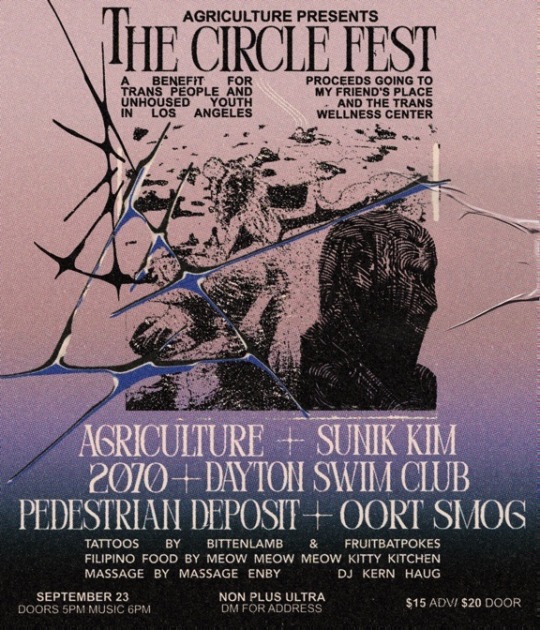
flyer by mario luna
#occupation#live music#los angeles#essential#pedestrian deposit#agriculture#sunik kim#2070#dayton swim club#oort smog#non plus ultra#the flenser
0 notes
Text
Over the weekend, Israeli settlers, backed by Israeli Occupation Forces, confiscated about 6 acres of my family's land. Land that has been with my family for generations & used for agriculture, seizing about 30 acres in total from our village over the weekend.
Israeli settlers, armed by the Israeli government, simply walked onto the land, set up tents, & now claim it as their own - and as Palestinians with the land ownership documents, there is absolutely nothing we can do.
This isn't the first time, either - just a couple years back, Israeli settlers seized about 3 acres from us & dozens more from others in our village.
& now, as Palestinians, we are no longer allowed to set foot on our own land, while Israeli settlers with citizenships from around the world [primarily the US] get "free" land, & will go on to establish an outpost & eventually a new settlement community, which will be funded & provided utilities by the Israeli government, who will then build discriminatory roads connecting it to the network of Israeli settlements built on Palestinian land throughout the West Bank.
It's utterly surreal to be living under a settler colony that continues to grow through the use of ethnic cleansing - because that is precisely what this is.
Those same settlers have been raiding our town for YEARS, but have dramatically stepped up their attacks this year - prior to anything that's happened in October. They've set fire to the homes & vehicles of friends, they've uprooted hundreds of olive trees, & spray paint "gas the Arabs" on our homes. People who resist by throwing stones at these invading groups have been shot at [and in several cases, killed].
This is why we resist.
5K notes
·
View notes
Text
Another update on Ahmed Kouta, the Palestinian-Canadian medical worker whose hospital has been shut down. Stranded in the North of Ghazzah by Justin Trudeau and Mélanie Joly's refusal to aid Palestinian-Canadians and their support for the zionist occupation regime. February 27th 2024. Ahmed keeps getting thinner, as no aid is coming through and the occupation has bombed everything that used to produce food, be it agricultural land or water aquifers or reservoirs of food or bakeries, etc... and has continued its siege of the city. I included a photo below next to the transcript for the video, of what he used to look like before this.


#cdnpoli#Justin Trudeau#Mélanie Joly#genocide#ethnic cleansing#starvation#Foreign Policy#zionist occupation of Palestine
712 notes
·
View notes
Text
A Spring Festival folk custom local to Chaoshan (Chaozhou and Shantou, Guangdong province) called 盐灶拖神/Yanzao tuoshen ("Yanzao (a village in Yanhong town, Chenghai district, Shantou city) God dragging").
This local custom falls under the greater folk custom of 游神/youshen ("walking the gods"). For youshen customs, and more specifically in Yanzao tuoshen, there is a "god walking team" responsible for carrying the palanquin upon which the god Ying Laoye (营老爷) sits. Ying Laoye is a protector deity local to Chaoshan. The custom of god-walking is not only related to prosperity but also is meant to strengthen the ties of the clans in the villages, and remind the people of their bond; Yanzao is what is known as a "natural village" (自然村落), a village that has been formed naturally after a long period of settlement by villagers whose main occupation is agriculture/farming. The village forms its own customs with family at the center of many of them, as many of the villagers are related. For example, Yanzao has about 20k people divided into four districts; among those numbers, there are about 10k surnamed Lin, 5k surnamed Chen, and 1k surnamed Li and Zhou.
When it comes to Yanzao tuoshen, the god walking team is tasked with safely carrying the god through the village. In the above video, the team is all wearing white. They will often wield incense that they use to hit outsiders with. In other tuoshen processions, the god walking team may be shirtless, their bodies covered in oil to make it difficult for outsiders to grab them and pull them out of the way. The goal of the outsiders is to find a way to get to the palanquin. If the outsiders are able to get onto the palanquin and maintain the position for a length of time, it will bring them good luck. However, surrounding people will usually very quickly pull them down again. If the palanquin is taken over by outsiders, then a "god saving team" will be dispatched to take back the palanquin and continue carrying it through the village.
Usually by the end of the procession, the god is dragged down from the palanquin and is broken apart and sunk into a body of water. On a later auspicious date, the god will then be fished back up, repaired, and returned to the temple for worship. This is meant to bring luck to the villagers.
One folk legend regarding this custom tells that there was once a very poor villager whose turn it was to worship the god, a custom which required him to treat the other villagers to a banquet. However, the poor villager was really too poor, and had no way of supporting others, so he secretly took the god's statue and dragged it to the seaside, burying it there and then running off in the night to Nanyang. Unexpectedly, that year, the village saw bountiful harvest and the poor villager also struck great fortune in Nanyang, leading the villagers to wonder if perhaps the god enjoyed being carried away. This is said to have lead to the tradition of dragging the gods.
Sources (Chinese):
盐灶拖神偶
澄海盐灶拖神习俗的文化解读
自然村落
730 notes
·
View notes
Note
do you know anything about native wildlife or plant life in palestine? particularly interested in primates because that's always what i'm most interested in but i'd really like to know more about what the animals and plants native to the land are like. what they were like pre israeli occupation and what sort of animal and plant life will need repairing when palestine is free. i hear a lot about the people and the human palestinian culture and it's wonderful but it's difficult for me to find anything regarding nonhuman life and i would like to learn more about it.
Honestly, the topic of Palestinian wildlife and its intersection with colonialism has been something that has increased a lot over the past couple of years. I can't offer anything about primate species (Palestine doesn't have any) but we do have lots and lots of very cool native animals like Gazelle and Caracal and Sand foxes and lots of bats and gerbils and snakes.
The Palestine Wildlife Society actually has a website with lists of all the animals found in Palestine and what level of conservation status they are at (plus the Arabic names): https://www.wildlife-pal.org/en
The Palestinian Central Bureau of Statistics also reported back in 2012 that:
There are about 51,000 living species (flora and fauna) in historical Palestine, constituting approximately 3% of global biodiversity.
In the West Bank and Gaza Strip there are an estimated 30,904 animal species, consisting of an estimated 30,000 invertebrates, 373 birds, 297 fish, 92 mammals, 82 reptiles, and 5 amphibians. Recent studies on birds in Palestine indicated that there are 373 species, which represent 23 Orders, 69 families, 21 Subfamilies, and 172 genera. The country also hosts 2,850 species of plants from 138 families.
And also added in 2014:
Israeli Violations are the main causes of Biodiversity deterioration
Based on 2012 data from ARIJ Research Institute, the Expansion and Annexation Wall has a total length of about 780 kilometers, of which 61% has been completed. The route of the Wall has isolated 680 km2 of Palestinian land between the Wall and the Green Line, comprising approximately 12.0% of the West Bank. This land comprises about 454 km2 of agricultural, pasture land and open areas, 117 km2 that were confiscated for Israeli settlements and military bases, 89 km2 of forest and 20 km2 Palestinian built-up land.
During 2013, more than eight thousand dunums of land were confiscated from Palestinians and more than 15 thousand horticultural trees were destroyed, causing considerable damage to the Palestinian environment and biodiversity.
The Israeli settlements and military bases also contribute in the biodiversity deterioration since there were 482 Israeli settlements and military bases in the West Bank at the end of 2013 contained around 563,546 settlers at the end of 2012.
Climate change is the most important natural factor that contributes to biodiversity degradation in Palestine. More animal and plant species have become under serious threat of becoming rare due to low rainfall, high temperatures, and the changing characteristics of the four seasons, in which drought is creeping into winter and spring.
The mountain Gazelle is currently endangered and this is due mostly to the building of roads and fences as well as predation and collisions with cars (the article also references the building of housing units in Mitzpeh Nafto'ah, which one of the areas where, in 2012, Israeli developers wanted to 'build up Jerusalem'). As of 2015, there were around 2,000 identified Gazelles within the Palestinian territories and historic Palestine. The mountain Gazelle look like this:
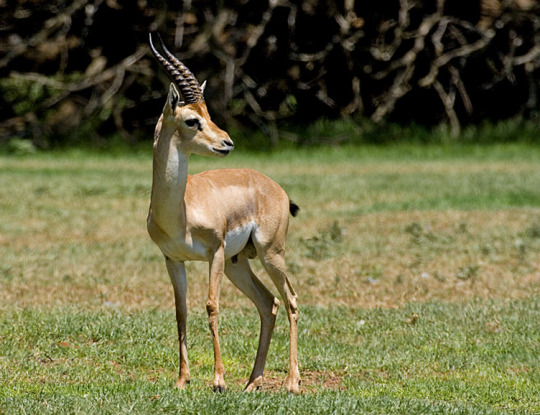
There have also been efforts for plant conservation in Palestine like the Iris Atrofusca, which has an extremely fragile population and is found almost exclusively within Palestine - a botanical garden was established for this particular Iris in the North Eastern Slopes of Palestine and in 2021, 120 clones of Iris Atrofusca were planted. Here is what they look like:

(also very interesting, sheep do not eat it!)
Probably most famous is the extinction of the Palestinian Crocodile, the last rhetorical circulation to 1935. Elizabeth Bentley wrote a great piece on it, you can read the full PDF on the Institute of Palestine Studies website or the edited (with permission) one published to Science for the People Magazine, I copied a segment from the latter here:
Colonial zoologists and collectors saw and appreciated Palestine’s bountiful plants and animals as objects of scientific inquiry. This scientific appreciation was inextricable from imperialist ambitions and the drive for profit. There were no wildlife protection laws in Palestine until 1924, which was after crocodiles’ likely regional extinction, and even then, the laws were loosely enforced. Colonial zoologists not only observed and wrote about Palestinian animals in their natural habitat. These zoological works were one of extraction and commodification.
Euphemistically termed processes of “collection” involved a network of human and nonhuman actors, whereby colonial zoologists hunted and killed Palestinian animals, studied them, and transported their remains overseas. Disemboweled, stuffed with wire and flax, and then displayed in glass cases, Palestinian animals were reanimated as spectacles for the viewing pleasure of museumgoers in London and Berlin.
While aligned with the broader trends in colonial zoology, the allure of the last Palestinian crocodile surpassed the confines of scientific inquiry; it adapted a symbolic, even mythical quality. Colonial zoologists’ ongoing speculation about Palestinian crocodile extinction necessitated a degree of willful (or internalized) unknowing about Palestine and Palestinians. Colonial zoologists were heavily dependent on Palestinians’ ecological expertise. Despite this, their writings convey mistrust and condescension toward Palestinians, along with a detachment from how local populations lived alongside Palestinian ecology.
Colonial scientific literature on Palestinian animals frequently perpetuated the racist, historically inaccurate outlook of “science for the West, myth for the rest.” Yet colonialist writings on the last Palestinian crocodile reflected their own symbolic attachments and investment in mythical thinking.
So there is a lot of work to do in regard to animal and plant conservation and several extinct animals I didn't bring up here but It is a deep dive and goes a lot farther than a lot of people consider. The Palestine Wildlife Society has a massive catalog and I hope you look through it!
1K notes
·
View notes
Text
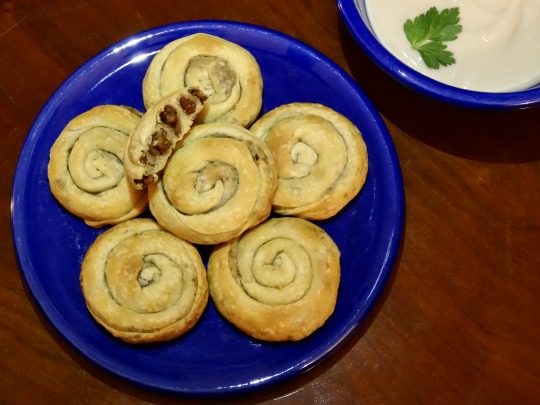
[ID: A group of pastry pinwheels on a blue plate next to a bowl of yoghurt garnished with parsley. End ID]
صفيحة يافاوية / Safiha yafawiyya (Yaffan pinwheels)
The dish
صَفِيحَة يَافَاوِيَّة ("ṣafīḥa yāfāwīyya") is a type of safiha, or flatbread, believed to have originated in the coastal city of يافا (yāfā; "Yaffa," sometimes "Jaffa"). While other versions of safiha consist of a flat piece of dough topped with meat, Yaffan safiha are made by rolling dough out to a transparent thinness, folding it to enclose a filling of meat or spinach, and then whirling it around into a pinwheel shape. More highly valued in Yaffa than flat safiha, Yaffan safiha inspires proprietary feelings amongst residents and emigrants. The technique has, however, spread to other areas in Palestine, as well as to Alexandria, Egypt, where a large number of Yaffan exiles have resettled.
Yaffan safiha may also be called "حواية" ("ḥawāya"), after a kind of towel that is stitched into a spiral and placed on top of the head to cushion it while carrying jugs of water, or trays that are hot from the oven. One Yaffan woman remembers her mother assembling these pastries at home and then bringing them, in a large copper tray, to the baker, so they could be cooked in a shared oven for a small fee. The baker's wife would have to wait to use the oven another day. The usage of communal ovens by those who do not have an oven in their home is still common practice in rural areas of Palestine.
Traditionally, the dough used to make Yaffan safiha includes only flour, salt, oil, and water. Some modern Palestinian recipes leaven the dough with baking powder; or include milk powder as a way to use food aid from NGOs, which seek to alleviate the effects of the Israeli occupation's extreme restriction of transport, travel, and agricultural activities on Palestinians' diets. With a spinach filling and without milk powder, the safa'ih may be described as "صيامي" ("ṣiyāmī): a word derived from "صِيَام" ("ṣiyām"; "fast") but which, due to the abstention from meat mandated during the Lenten fast, is colloquially used to mean "vegetarian."
Golden brown and fragrant with olive oil, these safa'ih combine layers of crisp, flaky dough with a savory, well-spiced filling. Recipes for both a 'meat' and a spinach filling are provided. A side of yoghurt and a garnish of mint round out the flavors of the filling and add tanginess and textural contrast.
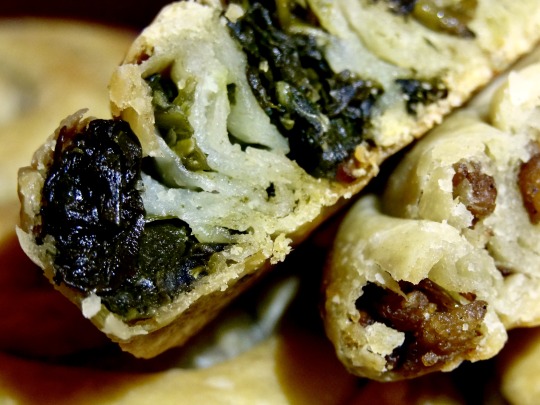
[ID: Close-up of two pinwheels cut open to reveal a spinach filling and a 'meat' filling between thin layers of pastry. End ID]
The Bride of Palestine
Yaffa is a port city with an ancient history which, until the 20th century, was the largest Arab city in, and the cultural and economic capital of, Palestine. For this reason it has sometimes been called عروس" "فلسطين ("'arūs filasṭīn"); "The Bride of Palestine." With the 1909 founding of the nearby Tel Aviv, Yaffa began to be considered its "twin" or "sister" ("האחיות") city; it had a distinctly Arab character where Tel Aviv was almost entirely Jewish. Yaffa was thus considered in disctinctly racialized terms: both attraction and threat; a source of authentic rootedness in the land which could be tapped, but also a potentially contagious bastion of Oriental "weak[ness]" ("חליש").
Yaffa had been a popular destination for culinary tourism in Mandate Palestine, with young settlers heading to the seaside to escape from religious studies and religious dietary restrictions—associated with diaspora Judaism and a lack of connection to a homeland—and to eat earthier Arab foods such as hummus, falafel, kebab, and ful.
In 1948, Zionist paramilitary organization Irgun dropped several tons of British bombs on major civilian areas of Yaffa in order to overwhelm resistance and empty the city of its Arab population; they destroyed the much of the Old City in the process. The neighborhood of المنشية (Manshiya) was destroyed shortly thereafter. Beginning in December of 1948, Yaffa was, part by part, annexed to Tel Aviv.
Today, despite the annexation and the Hebraization of the street signs, Yaffa maintains an Arab character in popular discourse. The call to prayer is heard in the streets, and the أبو العافي (Abulafia) bakery and أبو حسن (Abu Hassan) hummus restaurant and remain where they have been since the 1760s and 1970s, respectively. But increasing gentrification, rising rent prices, cafes and restaurants which cater to tourists and settlers, and the construction of Jewish-only residential projects threaten to continue the ethnic cleansing of the ancient city.
Yaffan Cuisine
Israeli occupation has tended to collapse some of the regional distinctions within Palestinian cuisine, as Palestinians are forced into exile or else crowded into Gaza and into smaller and smaller enclaves within the West Bank. Some dishes, however, still have variations that are associated with particular cities. Stuffed red carrots (محشي الجزر الأحمر; "maḥshi al-jazar al-'aḥmar"), cored and filled with rice and spiced meat, are a dish common throughout Palestine but cooked differently everywhere: in a sauce of lemon juice, pomegranate molasses, and red tahina in Gaza; in tamarind paste in Al-Quds and Ramallah; and in orange juice in the orange-rich Yaffa region. Abu Hassan restaurant serves مسبحة (msabbaha), a Yaffan classic in which chickpeas and tahina are mixed with green chili pepper, and lemon juice.
Donate to an evacuation fund
Buy an eSim for use in Gaza
Help Anera provide food in Gaza
Ingredients:
For the dough (makes 32):
500g flour (4 cups + 1 Tbsp)
1 tsp table salt
2 Tbsp olive oil
Enough water to form a soft, tacky dough (about 1 3/4 cup / 500mL)
For the meat filling (makes 16):
125g vegetarian ground beef (as a substitute for minced lamb)
1 small yellow onion, minced
1 Tbsp olive oil
1/2 tsp ground allspice
1/2 tsp ground black pepper
1/2 tsp ground cardamom
1/2 tsp table salt, or to taste
1/2 Tbsp ground sumac
1/2 Tbsp pomegranate molasses (optional)
For the spinach filling (makes 16):
500g spinach, washed and chopped
1 tsp kosher salt, for removing water
1 small yellow onion, minced
1 Tbsp olive oil
1/4 tsp ground black pepper
1/4 tsp table salt, or to taste
Squeeze of lemon juice
1 tsp shatta (hot red pepper paste)
1/2 Tbsp pomegranate molasses (optional)
Some recipes include sumac in the spinach filling, but this is not considered traditional.
Instructions:
For the dough:
1. Measure dry ingredients into a large mixing bowl. Add oil and mix briefly. Add water, a little at a time, until the dough comes together into a slightly tacky ball. Knead for five minutes, until smooth and elastic.
2. Divide dough into 16 balls of about 50g each. Roll it out into a cylinder and cut it in half repeatedly; or weigh the dough using a kitchen scale and divide by 16.
3. Pour some olive oil in a tray or baking sheet and coat each dough ball. Leave them on the tray, covered, to rest while you prepare the fillings.

For the meat filling:
1. Heat 1 Tbsp olive oil on medium-high. Add meat and fry, stirring often, until nearly cooked through.
2. Add onions, salt, and spices and fry until onion is translucent.
3. Remove from heat. Stir in sumac and pomegranate molasses. Taste and adjust. Let cool.
For the spinach filling:
1. Mix spinach with salt and let sit 10-15 minutes. Squeeze to remove excess water.
2. Heat 1 Tbsp olive oil in medium-high. Fry onion, salt, and pepper for a minute until translucent.
3. Combine all ingredients. Taste and adjust salt.
To assemble:
1. Oil a clean work surface, as well as your hands. Spread a dough ball out into a very thin, translucent circle by repeatedly patting with your fingers while pushing outwards. Be sure to push outwards from the center so that the circle does not become too thin at the edges. A few small holes are okay, since the dough will be folded and rolled in on itself.
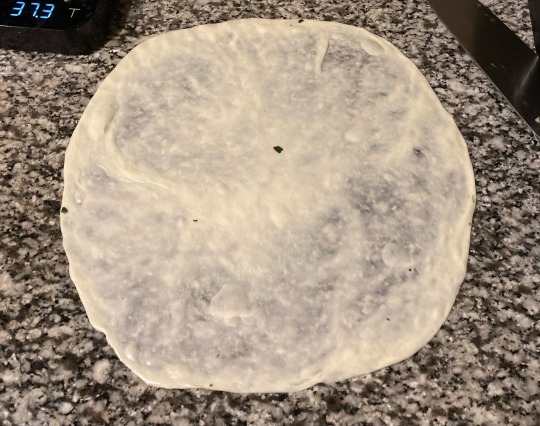
2. Cut the circle in half with a sharp knife. Spread 1/16 of either filling in a thin line along the cut edge, leaving a margin of 1 cm (1/2") or so.

3. Roll the edge of the dough (the cut edge) over to encase the filling. Continue rolling, trying as much as possible to exclude air, until you have a long rope of dough.
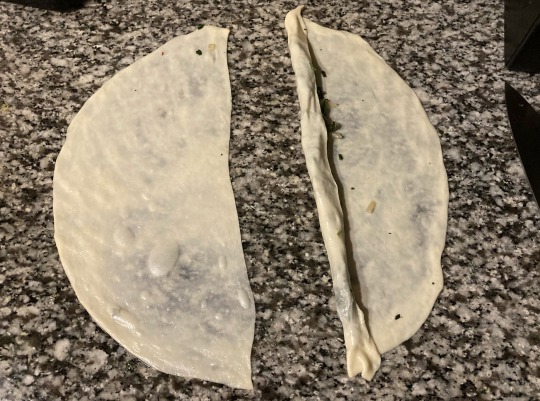
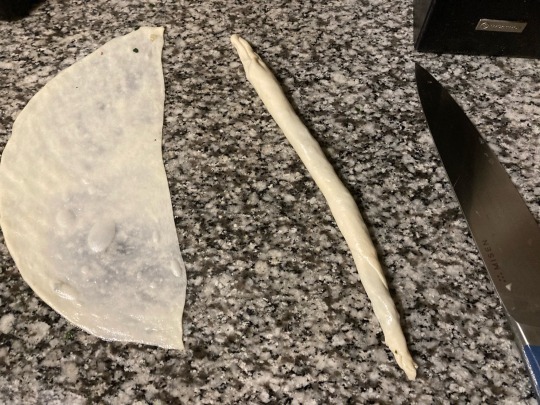
4. Roll the rope around in a tight spiral. Tuck the very end of the dough underneath and press to seal. Place on a preparing baking sheet.
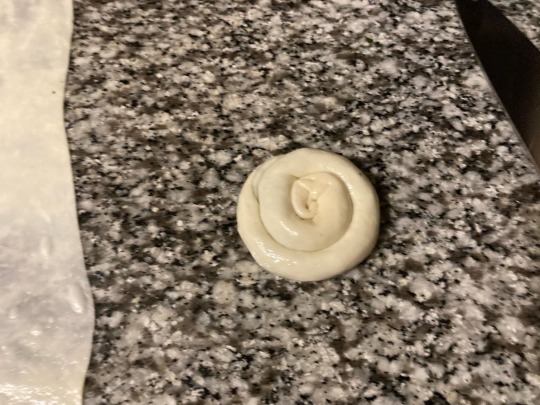
5. Repeat until the filling and dough are used up. Meanwhile, preheat an oven to 375 °F (190 °C). Bake the safiha in the top third of the oven for 25-30 minutes, or until golden in color.
Serve warm with yoghurt.
546 notes
·
View notes
Text

from 🧵
the entire palestinian coastal plain from haifa to rafah is underlain by a large aquifer. gaza possesses a significant lobe of it, in large part because of this: this is Wadi Gaza, known as Nahal Besor in Israel, one of, if not the largest drainage basins in the Naqab.
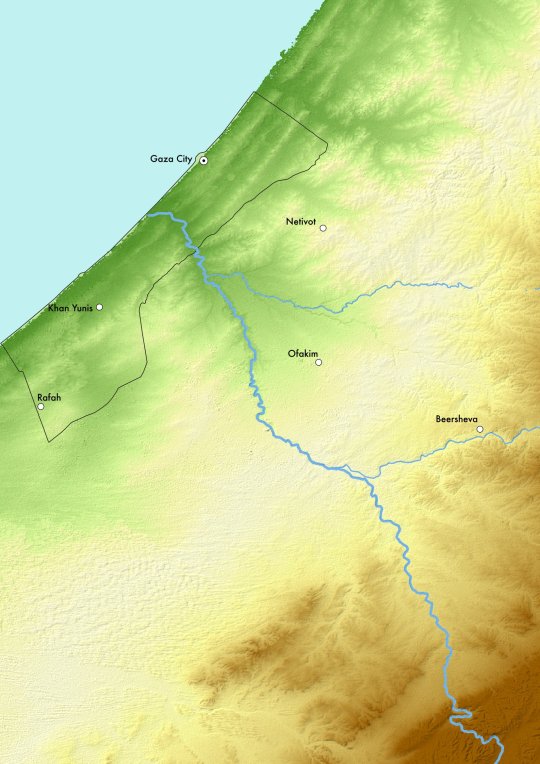
Wadi Gaza is a perennial stream in a country with very few of them. it's very small but occasionally subject to massive floods; the highly permeable coastal loess topsoil gives the coastal aquifer a relatively quick recharge time. photo shows the stream inside israel

so in theory there's no reason gaza should run short of water, even with 2.4 million people relying on it. well... this is what Wadi Gaza looks like inside the Gaza Strip. you may notice some differences.
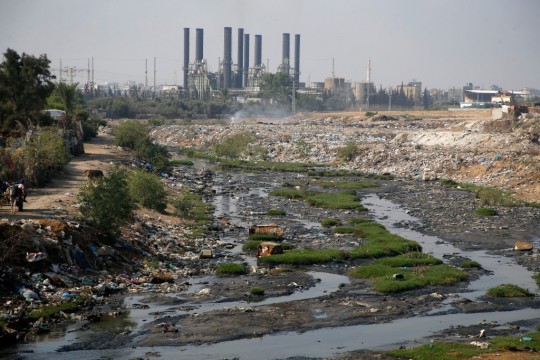
inside israel, i.e., upstream from gaza, huge amounts of water are pumped out of the aquifer in order to make all those kibbutzim and moshavim the highly productive agricultural communities that they are, and in order to sell the water to palestinians at a markup.
the river also naturally loses water through the riverbed, and this is not recharged, it doesn't have the flow rate inside gaza to carry pollutants out to sea. so they penetrate into the topsoil. where do all the pollutants come from? industrial and household wastewater.
gaza cannot import components to maintain its own water treatment plants, nor can it maintain its own energy supply, because israel restricts the importation of building materials, fuel, and other power sources (e.g. solar panels). so most wastewater goes untreated
as a result, wells are dug deeper, because the surface layers of water are contaminated. this causes horizontal subsidence, because gaza is adjacent to the sea, and saltwater infiltrates the water supply, making the water brackish. only about 5-10% of the wells in gaza are usable
can israel pump enough seawater into gaza's aquifer to render it completely undrinkable? yes, for as long as they keep the pumps going, and a few months afterwards. once they stop, fresh water flowing downhill from the israeli part of the aquifer will increase water pressure
salt water is denser than fresh water, so when fresh water flows into a brackish aquifer and water pressure increases, the salt water sinks deeper into the crust. in general, the artificial injection of desalinated water could restore gaza's water supply this way
if, of course, there were sufficient power to run all of gaza's desalination plants and water treatment plants, and if israel's water company stopped depleting the upstream aquifer (and, of course, if the risk of subsidence- and swelling-related earthquakes was mitigated)
IOW: the only reason this is a realistic plan for israel is bc they've spent the last 30-40 years already doing indirectly. even then, they'd need a lot more than five pumps. but the "permanence" of the effect is only true if the occupation and siege are also permanent
whereas, if the occupation and siege ended tomorrow, and even if 5 million people lived in Gaza, the area could regain not only its habitability but its famous and historic agricultural productivity within, at most, a couple of years.
end of thread
(Dec. 6)
818 notes
·
View notes
Text
But while bombs rain down, business continues as usual, with Israel granting 12 licences to six companies to explore for natural gas off the country's Mediterranean coast on October 30th. This is the latest venture to exploit one of several gas fields discovered on the Mediterranean coast over recent decades, aiming to solve Israel’s energy dependency and, crucially, Europe’s supplies.
The total oil and gas reserves were valued at a staggering $524 billion in 2019. But Israel does not have sole legal entitlement to the $524 billion, according to a UN report published in the same year. Not only is some of the $524 billion sourced from within the Occupied Territory of Palestine, much of the rest sits outside national borders in the deep sea, and thus should be shared with all relevant parties. The report questions the national right to these resources given they took millions of years to form—and that Palestinians occupied the whole territory until Israel’s recent formal creation.
The authors also note it is another war crime for the occupying power to deny the citizens the right to use their own natural resources, including diverting Palestine’s water supply, cutting off access to their fisheries, grabbing agricultural land and destroying olive groves. The financial costs are massive. “To date, the real and opportunity costs of the occupation exclusively in the area of oil and natural gas have accumulated to tens, if not hundreds, of billions of dollars.”
[...]
Israel’s invasion of Gaza in December 2008 brought the Palestinian gas fields under Israeli control—without regard for international law. The BG Group has been dealing with the Israeli government ever since. The UN estimates billions of dollars in loss for the Palestinian people.
But more gas for everyone else.
991 notes
·
View notes
Text
Alright I'll bite. I live in Israel, yes. I served in the army, yeah. Does Israel mistreat Palestinians in Gaza and the West Bank? Absolutely. My friends who are still enlisted tell me about the shit show that goes in there every day. I get it, there are a million reasons to hate the government and the IDF and whoever else you point fingers to. No side is innocent.
But assholes on motorcycles and in pickup trucks broke through the fence, entered civilian towns and military outposts alike, and just started MASACARING EVERYONE. THIS SHIT IS UNPRECEDENTED. And some MIGHT tiptoe around the point, and say that taking over outposts is fair because it's an occupation force and colonialism and what have you, but for fucks sake
They entered civilian homes. They shot everyone who moved. In locked houses, they set the home on fire and shot the families as they fled. I heard the phone calls - people screaming and begging for their lives as terrorists are walking around their home, stealing possessions, massacring everyone.
They didn't just murder colonialists, militants, occupying forces. They murdered kids who should've gone to school today. Parents working local agriculture, teachers, normal guys with an office job. They murdered dozens of elderly people who couldn't run away.
Not only murdered. Kidnapped. Living and dead, put on pickup trucks and herded back to Gaza. Stripped naked, desecrated and paraded around Gaza. I dare you to tell me the party goers, who were at a rave near one of the Kibbutzim near the fence, deserved to be shot at as they ran to safety. Hundreds of people missing. My Instagram stories filled with their faces, and a phone number attached - "help us find our loved ones. Contact lost. If anyone knows anything-" and at this point I skip them because there's nothing I can do.
My friends are enlisted down there. We're just a bunch of 20 year olds. My best friend is defending one of the villages who were infiltrated, she's trading shots with gunmen who already murdered half the place, she's messaging me once in a while to let me know she's alive. She should've been home for the weekend, we were supposed to watch Chicago now that it's on Netflix. Now neither of us sleeps, she's putting her life on the line and I'm wide awake terrified of the moment they call me and tell me she's gone.
This is mostly a rant. If you read all of it, thanks. I live up north, no need to worry for my safety for now. I don't have a good ending for this. Just, stay safe, I guess.
955 notes
·
View notes
Text
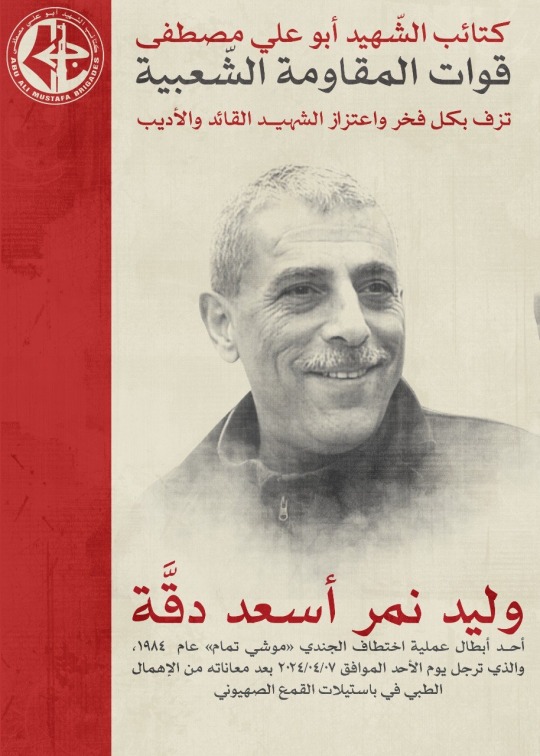
Martyr Abu Ali Mustafa Brigades:
The Martyr Abu Ali Mustafa Brigades - Popular Resistance Forces exalts with all pride and honor the martyr leader and writer, Walid Nimr As'ad Daqqah.
One of the heroes of the kidnapping operation of the soldier "Moshe Tammam" in 1986, who dismounted today, Sunday 7/4/2024 after suffering from medical negligence in the bastilles of zionist repression.

Popular Front for the Liberation of Palestine:
The Popular Front mourns the imprisoned national and Frontsman leader, the great intellectual, thinker and writer, Walid Daqqah “Abu Milad”.
With the greatest sadness, grief, and revolutionary anger, the Popular Front for the Liberation of Palestine mourns, in the name of its Secretary-General and his deputy, the Political Bureau, the Central Committee, its fellow prisoners, and all the comrades in the homeland and the diaspora, its companion, the great national and Front leader, the prisoner, the intellectual, the revolutionary thinker, and the writer Walid Nimr As’ad Daqqah “Abu Milad,” 62 years old, one of the most prominent leaders, theorists, and thinkers of the prisoners’ movement, who was martyred this evening as a result of a policy of medical negligence after suffering from a long illness.
The Popular Front extends to the comrade leader, Secretary-General, Ahmed Saadat, the comrades in the prison branch and the prisoner movement, his struggling wife, Sanaa, his daughter Milad, his entire family, and all his comrades, its deepest condolences on the martyrdom of this comrade, leader and inspiration, one of the generals of steadfastness, and the distinguished national and Front leaders and writers who engraved their name in letters of gold for what he presented in rich and inspiring struggle experience for many generations of prisoners in the occupation prisons. He also had a rich and distinguished intellectual and literary experience that was unparalleled in its influence on the lives of the prisoners, its meanings, its revolution, and its exploits. He was one of the most prominent symbols of prison literature. Rather, it is its dean and first writer, as he contributed important intellectual and literary studies to the Palestinian, Arab and international library. In parallel, the martyr was one of the most prominent national leaders and prisoners of the occupied interior who advanced the ranks in confronting the practices and violations of the occupation, and participated in all the struggle battles of the prisoner movement.
Biography of Comrade Commander Walid Daqqah “Abu Milad”:
- Born on July 18, 1961.
- He is from the town of Baqa al-Gharbiya, Haifa district.
- Commander Walid grew up in a Palestinian family consisting of 6 brothers and 3 sisters.
- The martyr received his basic education in Baqa al-Gharbiya schools, and obtained his high school diploma in 1979 from Yimma Agricultural Secondary School. He joined the university and continued his scientific and academic studies.
- During his studies, his views and awareness of the issues of his people and his deep affiliation to his Palestinian national identity blossomed.
- In 2010, he obtained a bachelor’s degree in the interdisciplinary study of democracy, and in 2016 he obtained a master’s degree in regional studies, “Israeli Studies track” from Al-Quds University, but he was unable to complete his preparation for the degree of PhD.
- He joined the ranks of the Popular Front for the Liberation of Palestine in 1983, and joined a military cell affiliated with the Front.
- In 1984, he received military training at the Front’s military bases in Syria, and then he contributed to the formation of a secret military apparatus for the Front inside the occupied interior, whose mission was to collect information about zionist leaders and officials who participated in committing massacres in the invasion of Lebanon.
- The martyr Walid and his comrades within the military cell carried out a series of operations, including the kidnapping and killing of the zionist soldier “Moshe Tammam”, as a result of which he and a group of comrades were arrested and sentenced to life imprisonment.
- He completed his sentence in March 2023, but an additional two years were added to his sentence because he was accused of smuggling mobile phones into prisons.
- He was among 23 prisoners whom the occupation refused to release in all exchange deals. The occupation also withdrew from placing him on the list of released long-term prisoners in 2013-2014.
- He is considered one of the most prominent prisoner theorists and thinkers inside the occupation prisons. He has intellectual and literary productions that have reached the international level, the most famous of which are the books “The Melting of Consciousness” and “Parallel Time,” and the novel “The Story of the Secret of Oil,” which won international fame and many awards, continued with the novel “The Story of the Secret Sword,” a second part, and it was expected that the third part, “The Tale of the Secret of the Spectrum,” would be published.
- His book, Fusion of Consciousness or “Redefining Torture,” is considered one of the most prominent productions of the prisoner movement, and is considered an important reference. Through this study, he laid out the ABCs of steadfastness, discipline, rooting organizational work, and the strength of the will inside prisons. He is also credited with crystallizing concepts that describe the reality inside prisons, such as the concept of “Parallel Time” (i.e., the time of prisoners versus the time of those outside the prisons), and he wrote a large number of political, intellectual, and literary articles and studies, and is considered a first-class political thinker. He produced inside the occupation prisons a huge intellectual project during which he answered all issues, inquiries, and existential questions, as well as issues of liberation, strengthening the state of criticism within it, on his way to reaching the truth and the crisis of the national project. He was a painter who provided the prison with many important national paintings, speaking the Hebrew language fluently.
- He was subjected to torture, solitary confinement, and being prevented from visiting during his long detention, and his writings and publications were pursued by the Prison Service.
- He smuggled sperm out of prison, became a father at the age of 57, and gave birth to a daughter he called “Milad.”
- On December 18, 2022, it was announced that he was suffering from a rare bone marrow cancer, as a result of which his health condition deteriorated and he was transferred to the hospital. In June 2023, his request for release was rejected, and the Central Court also rejected the appeal he submitted against the committee’s decision.
- He died this evening as a result of a policy of medical negligence, after a serious deterioration in his health.
As the Popular Front for the Liberation of Palestine bids farewell to its comrade, the leader, thinker, writer, inspiration and great theoretician, it pledges to him to be loyal to his national, intellectual and Front legacy, through which he made Palestine and the cause of its liberation his compass. Until his departure, he remained inhabited by Palestine, all of Palestine from its river to its sea.
Glory to the great martyr of Palestine and humanity.
We will certainly be victorious.
Popular Front for the Liberation of Palestine
Central Information Department
7-4-2024

RNN Prisoners:
"You are the most beautiful smuggling of my memory. You are my message to the future."
Milad Walid Daqqah is the product of struggle, steadfastness, and hope for the future.
Abu Milad, who ascended to martyrdom today at 62, spent most of his life in the colonial prisons, since he was 24, for allegedly kidnapping and killing IOF soldier Moshe Tammam in 1986.
Sanaa interviewed him in prison, and they fell in love, marrying in 1999 inside the very prison. After years of trying, Sanaa gave birth to beautiful Milad, one of dozens of children borne out of smuggled sperm. Walid was punished, sent to solitary confinement for creating life outside the confines of the prison walls.
He wrote to his daughter:
"Who will take the rest of my life and grant me a moment of embrace with your tiny arms. Who, my little one, who with your tiny hands brushed against my heart, making the pulse steady, the body heal, and decades of pain vanish. Who, my heart's joy, will come to rest on her father's chest, so he can caress her soft hair...
To my beloved Milad.. Happy birthday and may you have thousands of moments of joy.
Your father, Walid Daqqah."
In fact, Walid named Milad, which means "birth," nearly 10 years before she was miraculously born in 2020. In his 2011 letter to Milad, he wrote:
"Dear Milad,
I have now reached the age of 50, and my years have been split halfway between prison and life, for prison is a fire that feeds on the fragments of my memory. And my memory, O joy of my heart, has become brittle and its roots have dried. As for you, you are the most beautiful smuggling of my memory. You are my message to the future."
Walid did not see his freedom, and Milad did not see Walid. But Walid and Sanaa left behind an enduring tale, a living testament to continue his story and path.
"I admit that I am a human still holding onto his love, gripping tightly, as difficult as it is, with all my might. I will remain steadfast in this love. I will continue to love you, for love is my only humble victory over my jailer."


280 notes
·
View notes
Text
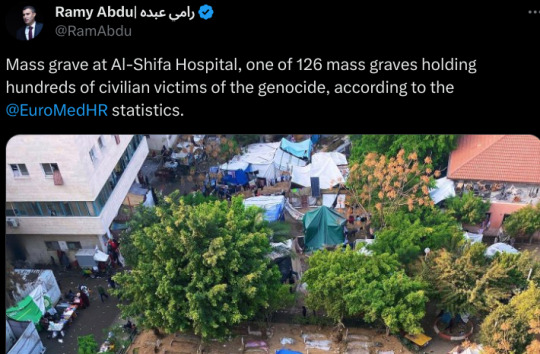
Mass grave at Al-Shifa Hospital, one of 126 mass graves holding hundreds of civilian victims of the genocide, according to the @/ EuroMedHR statistics. [@/ RamAbdu on X. 01/01/24.]

Happening Now | Heavy bombardment with shrapnel reaching the displacement center at a nearby school as the occupation bombs agricultural lands in Nuseirat refugee camp. [@/ Timesofgaza on X. 01/01/24.]
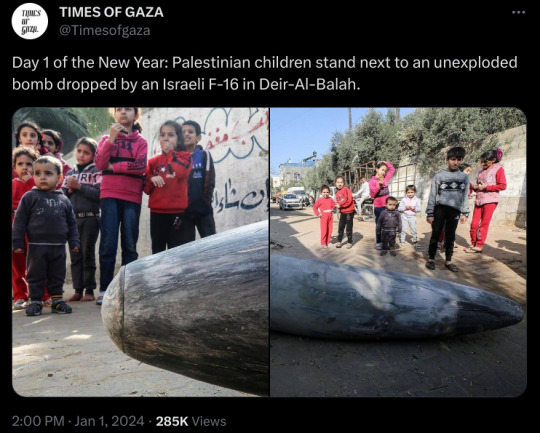
Day 1 of the New Year: Palestinian children stand next to an unexploded bomb dropped by an Israeli F-16 in Deir-Al-Balah. [@/ Timesofgaza. 01/01/24.]
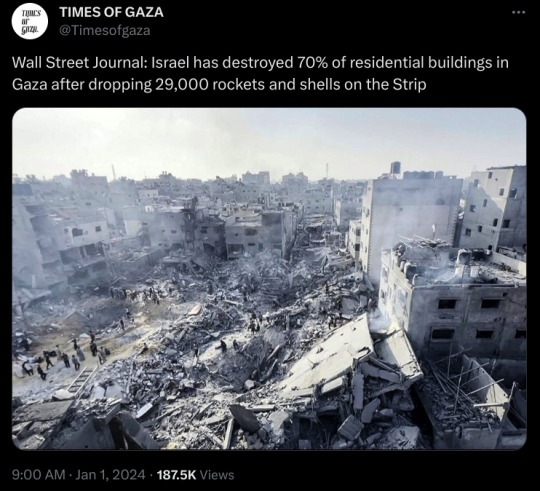
Wall Street Journal: Israel has destroyed 70% of residential buildings in Gaza after dropping 29,000 rockets and shells on the Strip. @/ Timesofgaza on X. 01/01/24.]
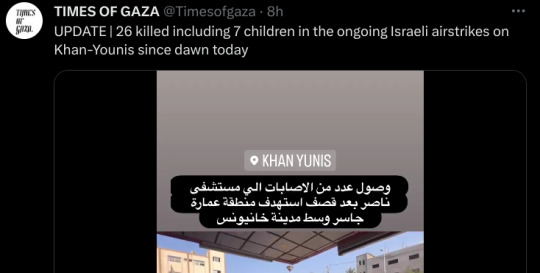
UPDATE | 26 killed including 7 children in the ongoing Israeli airstrikes on Khan-Younis since dawn today [@/ Timesofgaza on X. 01/01/24.]
IOF strikes and bombardments in and around Bir al-Naja area, Khan Younis, Nuseirat, and Deir Al-Balah this past day. Dozens of Palestinian people were killed. This continues to be beyond horrifying and despicable.
#feminist#feminism#social justice#free palestine#palestine#freepalastine🇵🇸#free gaza#settler violence#settler colonialism#colonial violence#israel is a terrorist state#israel is a war criminal#israel is committing genocide#current events#war crimes#end the occupation#end the genocide#ceasefire now#ceasefire
709 notes
·
View notes
Text
All day, I have been doing my best to avoid manipulations regarding the consequences of russians blowing up Kahovka HPP Bridge, but as the catastrophe unfolds, grim understanding kicks in. Many elderly people and people with mobility issues were not able to evacuate before the water flooded their houses. We won't know the extent of the losses until or if the water recedes. Same with domestic animals, animals from the zoo, and rare wildlife species. Thousands of people in the South of Ukraine are losing their homes and being displaced as I am writing this in Kyiv.
Meanwhile, the water washes away mines planted by russian soldiers, and they detonate uncontrollably, floating in the current. Also, russians continue to shell the region to hinder the evacuation efforts of Ukrainian authorities.
Fertile lands are being lost to the flood. This is a huge blow to Ukrainian agriculture and a direct threat not only to ourselves but also to the livelihoods of many countries in the Global South dependent on Ukrainian crops.
The Southern regions of Ukraine are about to face technical and drinking water shortages. Some parts are controlled by Ukraine and may count on humanitarian support. Others are currently under russian occupation, i.e., completely on their own in the face of devastating, life-threatening tragedy.
The Zaporizhzhia Nuclear Power Plant, which is currently occupied by russians, is likely to lose a lot of water used for its cooling systems. russians have also been intimidating and torturing its staff, who stayed there to avert nuclear catastrophe amid the occupation.
This is hell. We can only hope to save as many lives as possible. No country would inflict something so monstrous on itself. Please do not be fooled by the so-called ambiguity promoted by russian propaganda and some Western media. Kahovka HPP Bridge has been mined by russians for months and overlooked by the allies of Ukraine despite frequent warnings by our authorities.
This is a russian doing. This is a war crime under the Geneva Conventions. This is an act of terror and ecocide sponsored by the russian people.
2K notes
·
View notes
Text
[The Israeli burning of olive-tree groves] is familiar to thousands of Palestinian families. In the name of security, Israel systematically removes them from the land and erases their historic rootedness to this geographic place. For Palestinians, food and agriculture are not merely a pastime; they are a way of life. Without it, they’re rendered powerless economically, voiceless politically and devoid of their own cultural legacy. Yet that’s exactly why a sovereign and self-supporting food system is an early target of the Israel.
The Israeli occupation has transformed the Palestinian food system, converting it from a producer society to a consumer society, according to multiple West Bank residents. A tangled web of laws makes it difficult to sell crops or products like tahini for prices high enough to function as a sustainable income, and settlements continue to encroach upon Palestinian villages, seizing arable land and restricting access to crucial natural resources like water. Food is the first frontier of this conflict, and the Palestinian right to produce, sell and eat local food is a barometer for the future viability of the resistance movement.
[...] [In 1994, Israel and Palestine] signed the Paris Protocol to regulate economic interaction. The agreement hamstrung any hopes at Palestinian economic development, all but guaranteeing it would become dependent on Israel. It gave Israel full control of borders and put the sole customs clearinghouse under its jurisdiction. Goods entering and exiting Palestine remain subjected to Israeli taxes. Palestinian exports are heavily taxed while Israeli goods enter Palestine freely. Israeli goods, especially produce and food-related products like tahini and olive oil, flood the market with alternatives cheaper than local options.
What’s transpired as a result is the dramatic transformation of Palestine, says Raya Ziada, who founded an acroecology nonprofit based in Ramallah. “We depend on other people, whether that’s Israel or international aid, and we have to follow other people’s direction on producing food.”
Raya and others argue this is a deliberate act by the Israelis to handicap opposition to the occupation.
—Carly Graf, "Food Is the First Frontier of the Israeli-Palestinian Conflict," 2019.
435 notes
·
View notes
Text
So @shashiatnight sent me this great video about Palestinians' reliance on the land and I felt it was a nice summary of indigeniety vs relationship to the land vs colonialism.
Palestine, before the occupation, had thriving city centers but was primarily an agricultural community, meaning that the people relied on the land for their livelihood. Palestinian culture requires the land to survive so the occupation and control of the land itself is an occupation of the culture is an occupation of the people's self identity.
This is why I'm so insistent that we define indigeniety correctly, because a lot of the time, people misconstrue my words to imply "noble savagery" when... it's not. It's a fact that we rely on the land so we need to care for it. Of course we love the land and the olive trees, who doesn't love the plants they take care of?
Sure there are Palestinians that aren't taking care of it, but the biggest threat throughout every indigenous community is from the colonial forces that alter the environment to suit its needs.
298 notes
·
View notes
Text
“Failed presidential candidate Gov. Ron DeSantis (R) signed a bill late last week barring Florida localities from requiring employers to provide outdoor workers with access to water, rest and shade, outraging workplace safety advocates who say the new law will kill people.
Backed by the agricultural and construction industries, the controversial legislation is what’s known as a “preemption” law: It forbids cities and counties from pursuing their own ordinances on a particular subject, in this case protections from extreme heat.
The law effectively nullifies a proposal in Miami-Dade County that would require some employers to maintain a heat safety program and provide employees with water and shade on hot days. The county commission recently withdrew the proposal after the state legislation put its legality in doubt.
The preemption bill recently passed the Republican-controlled state House and Senate, along with a similar measure that prevents jurisdictions from requiring employers to pay livable wages on government-funded projects.
Unions and other progressive groups said blocking heat regulations would endanger farm and construction workers and anyone else who labors in one of the hottest states in the country.
“Someone is going to die as a result of this legislation,” Kim Smith, a telecommunications technician, told HuffPost last month.
Last year, Texas Republicans passed a similar preemption bill that blocked localities from implementing heat protections as well as other ordinances related to housing and labor. The legislation, known as Texas’ “death star bill,” appeared designed to thwart local laws in Austin and Dallas that guaranteed water breaks for workers.
The bill Gov. Ron DeSantis (R) just signed blocks jurisdictions like Miami-Dade County from implementing their own heat safety standards.
The bill Gov. Ron DeSantis (R) just signed blocks jurisdictions like Miami-Dade County from implementing their own heat safety standards. SOPA IMAGES VIA GETTY IMAGES
Florida Republicans pushing for the preemption law said they wanted to avoid a “patchwork” of local regulations around the state related to heat safety, arguing the matter was better left to the federal Occupational Safety and Health Administration.
But OSHA does not yet have a heat-specific safety rule, and proposals to create a uniform, statewide standard in Florida have gone nowhere over the years because of a lack of Republican support.
More than 430 workers have died due to environmental heat exposure since 2011, according to OSHA. But relatively few jurisdictions have laws in place that require employers to provide water, shade and heat safety training. Just three — California, Oregon and Washington — mandate heat breaks for outdoor workers. Minnesota has heat standards for indoor workers, while Colorado does for farmworkers.
“Overheating is one of the most common and most serious dangers in the workplace,” Rep. Alma Adams (D-N.C.), who recently co-authored a federal bill ordering OSHA to regulate heat exposure, told HuffPost. “Is requiring a glass of water and some shade too much to ask?”
Climate change is making heat waves both more intense and more frequent, raising fears that a growing number of workers could die if governments don’t implement safety measures.
A farmworker in Miami-Dade County died last July during what would become the hottest month ever recorded. The man’s family told NBC South Florida that he’d recently suffered symptoms consistent with heat stress. A farmworker in the county told HuffPost last month that the foreman at the plant nursery where he works prohibited even 30-second breaks in the blazing sun since this is the busiest growing season for exotic flora.
The Biden administration is currently crafting a federal heat safety standard through OSHA, but federal rules take years to develop, often face litigation and can be undermined by subsequent administrations. Former President Donald Trump could simply drop pursuit of the rule if he defeats Biden in their expected rematch in November.”
230 notes
·
View notes